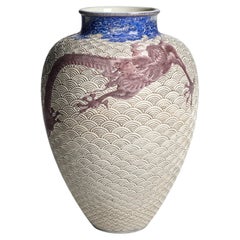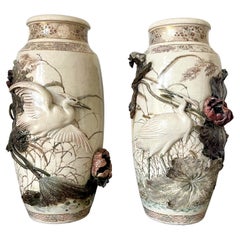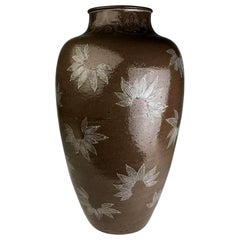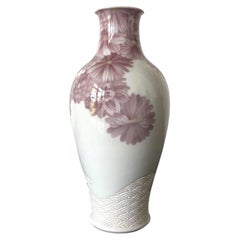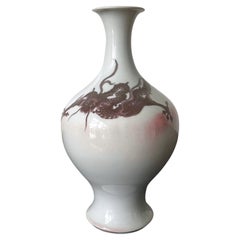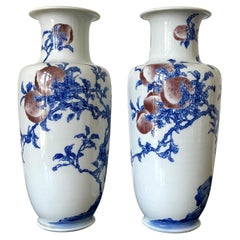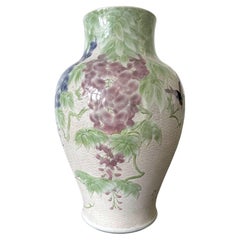Makuzu Kozan Vases
13
to
13
13
13
13
4
9
9
3
2
Height
to
13
5
13
13
13
20
1,023
536
394
361
Creator: Makuzu Kozan
Large Japanese Ceramic Vase by Makuzu Kozan Meiji Period
By Makuzu Kozan
Located in Atlanta, GA
A large Japanese ceramic vase by the celebrated Meiji imperial potter Makuzu Kozan (1842-1916) circa 1880-1890s. Dated to his underglaze phase post 1887 after he successfully mastered the new colors available from the west and used them to the best advantage in his work deeply rooted in Japanese aesthetics. The vase has an impressive size and was potted in the classic baluster form with an elegant proportion. The surface is decorated using a combination of techniques of low relief sculpturing...
Category
Late 19th Century Japanese Meiji Antique Makuzu Kozan Vases
Materials
Ceramic
Rare Pair of Early Period Makuzu Kozan Takauki High-Relief Vases
By Makuzu Kozan
Located in Atlanta, GA
A stunning pair of ceramic vases with gilt, paint and high-relief decoration by imperial artist Makuzu Kozan (1842-1916, also known as Miyagawa Kozan) circa 1876-81 (late Meiji period). These vases belong to early period (1876-1881) of Kozan's repertoire, during which time the high relief sculpturing (known as Takauki ware) was used as a distinguished technique on top of the traditional gilt and paint ornaments of satsuma ware. Due to the relatively limited production and the fragile nature of these wares, not a large quantity of the examples remained in the first place, not mentioning a fine matching signed pair in such impressive sizes.
Not only a rarity, this pair of vases is also superb in workmanship, thus the fine example of the work from that short and unique period of the artist's career before he switched to the underglaze period. In a conceptually mirrored fashion, the surface is richly decorated with flying cranes among large lotus leaves and flower, like an idyllic aqua scenery of pure poetry on a circular scroll. The high-relief appliques were rendered and composed in realistic fashion but with a dramatic touch. They are literally about to break the surface free, alive and in motion. The dark colors of the glaze were used to set a moody tone. The approach to create this type of ornamentations is more akin to sculpturing an ink painting in three-dimension than ceramic making. It is not hard to imagine the demand of both the artistry and the technique.
Both vases were signed as "Makuzu Kozan Kiln" and each further with another name and seal, which are most likely the individual artist involved in the making process. Similar signatures can be seen in the reference book below.
For similarly Takauki vases, see Miyagawa Kozan Makuzu...
Category
1870s Japanese Japonisme Antique Makuzu Kozan Vases
Materials
Ceramic
Rare Large Vase with White Slip Inlay Makuzu Kozan Meiji Period
By Makuzu Kozan
Located in Atlanta, GA
A impressively large and unusual stoneware vase in an urn shape from the studio of Japanese Potter Makuzu Kozan, also known as Miyagawa Kozan (1842–1916), one of the most established and collected ceramist from Meiji Period. Born as Miyagawa Toranosuke, Kozan established his pottery studio in Yokohama circa 1870s and later became one of the appointed artist to the Japanese Imperial household. His work was exhibited in many international fairs that the Meiji government participated at the turn of the century and won many grand prizes.
This vase is dated to the end of Makuzu's life circa 1910-1916 based on similar work created around that time. After achieving domestic and international fame, Makuzu retired and handed the business to his son Hanzan in 1912. He dedicated his time to other selected projects that were more in tune with Japanese sensibility than export aesthetic. He made a group of stoneware pottery pieces inspired by Edo master like Ninsei and Kenzan as well as his own poetic creation. This piece is attributed to that period.
Standing of an impressive size, this vase is more like an urn, made with stoneware instead of porcelain. It was coated with a brown iron glaze with a slight translucent quality. Underglaze whit slips were used to draw low relief decoration of bamboo leaves that sparsely scatter on the surface. Slightly more elaborate scrolling vines and autumn flowers circles under the mouth rim. Same white slip inlay was used to sign the vase under the base. The whole effect of the piece is unusual. With its dark glaze in contrast with the sparse white decoration that is more abstract and geometric than realistic, it appears almost modern with an Art Deco flavor.
For stoneware urn and vase in the similar genre by Makuzu Kozan: see figure 113 on page 182 of "Sekai ni Aisa Reta ya Kimono" MIYAGAWA KOZAN MAKUZU...
Category
1910s Japanese Japonisme Vintage Makuzu Kozan Vases
Materials
Ceramic
Japanese Ceramic Vase with Delicate Carvings by Makuzu Kozan Meiji Period
By Makuzu Kozan
Located in Atlanta, GA
A delicate and rare Japanese ceramic vase by the important Meiji imperial potter Makuzu Kozan (1842-1916) circa 1887-1910. Dated to his underglaze phase post 1887 after he successful...
Category
1890s Japanese Japonisme Antique Makuzu Kozan Vases
Materials
Ceramic
Japanese Porcelain Glazed Vase with Dragon Design Mazuku Kozan
By Makuzu Kozan
Located in Atlanta, GA
A porcelain vase with dragon design by Japanese imperial potter Makuzu Kozan (1842-1916), circa 1900s. The vase is made in what is considered early phase of his underglaze period during late Meiji era. In a classic baluster form, the surface of the vase was decorated with a slithering dragon in underglaze iron red circulating the exterior among pink clouds. The animated rendering of the dragon is fine and detailed, with five claws, scales, long tails and highlighted eyes. The pink cloud is misty and called Morotai or the hazy style, created with a unique technique developed in Kozan's studio called fuki-e by blowing the pigment powders onto the surface. Kozan Studio experimented with newly available colors from the west starting in the 1880s, which resulted in the expansion of the palette and style that bridged the east and west aesthetic tradition. Marked in underglaze blue on the base.
Known also as Miyagawa Kozan...
Category
Early 1900s Japanese Japonisme Antique Makuzu Kozan Vases
Materials
Porcelain
Pair of Rare Porcelain Commemorative Vases by Makuzu Kozan Meiji Period
By Makuzu Kozan
Located in Atlanta, GA
A pair of porcelain vases in classic form, decorated with underglaze blue and copper red painting by Imperial potter Makuzu Kozan. Also known as Miyagawa Kozan (1842–1916), Makuzu was one of the most established and collected ceramist known to the west from Meiji Period.
The vases are in a classic Chinese form called "Bang Chu Ping" (grain-mallet vase...
Category
1910s Japanese Japonisme Vintage Makuzu Kozan Vases
Materials
Ceramic
One of The Two Japanese Ceramic Vases Makuzu Kozan Meiji Period
By Makuzu Kozan
Located in Atlanta, GA
Two small nearly identical ceramic vases by Japanese Meiji imperial potter Makuzu Kozan (1842-1916), circa 1890-1900s. The vases were made in the form of jarlet with swelled shoulder...
Category
Late 19th Century Japanese Japonisme Antique Makuzu Kozan Vases
Materials
Ceramic
Fine Japanese Ceramic Vase Makuzu Kozan Meiji Period
By Makuzu Kozan
Located in Atlanta, GA
A Japanese long neck porcelain vase circa 1900-1910s by the studio of Miyagawa Kozan (1842–1916), one of the most established and collected Japanese ceramist from the end of Meiji Period. Commonly known as Makuzu Kozan, which also appears as the signature on his work, his originally birth name was Miyagawa Toranosuke. He was the appointed artist to the Japanese Imperial household and his work was exhibited in many international fairs that the Meiji government participated at the turn of the century.
This vase features an elegant Classic form with a slender neck and slightly flared mouth above a baluster body. It was finely painted with two swimming carps in a copper red underglaze among green ribbons like waves. The background display a brilliant verdant green overall, Around the fish a poetic hazy effect was emphasized for a visual complexity by Fuki-e (the blow painting), an invention in Kozan's studio. The new technical development of chemical colors from the west was embraced circa 1900s in Kozan studio. This empowered the more creative experiments with not only colors, but also concept of dimension, which led Makuzu Kozan's work to become a bridge between East and West aesthetics. This is particularly evident in this vase with the Masterly details of the brush strokes, the expertly employment of gradient of color, and a very realistic and detailed rendering of the fish and their vivid motions.
For two similar examples of Kozan's work with similar carps decoration, see Page 148-149 of the book: Sekai ni Aisa Reta ya Kimono Miyagawa Kozan Makuzu...
Category
Early 20th Century Japanese Meiji Makuzu Kozan Vases
Materials
Ceramic
Japanese Porcelain Vase Meiji Period Makuzu Kozan
By Makuzu Kozan
Located in Atlanta, GA
A finely decorated and glazed Japanese porcelain vase by Makuzu Kozan (1842-1916) circa 1900s Meiji Period. The vase is of a classic bottle form with baluster body and short neck. It was decorated with underglaze white magnolia blossom on a pleasant celadon background. The stamens of the flower were artistically rendered in a low relief, giving the design a realistic appeal with the dimension.
Miyagawa Kozan...
Category
Early 20th Century Japanese Meiji Makuzu Kozan Vases
Materials
Porcelain
Japanese Porcelain Vase Makuzu Kozan Meiji Period
By Makuzu Kozan
Located in Atlanta, GA
A striking blue and white vase from the studio of Japanese Potter Makuzu Kozan, also known as Miyagawa Kozan (1842–1916), one of the most established and collected ceramist from Meiji Period. Born as Miyagawa Toranosuke, Kozan established his pottery studio in Yokohama circa 1870s and later became one of the appointed artists to the Japanese Imperial household. His work was exhibited in many international fairs that the Meiji government participated at the turn of the century and won many grand prizes.
Of a relatively large size, this vase is decorated with underglaze cobalt blue using the novel technique developed by Kozan called Fuki-e (the blow painting). As a result, the bamboos appear took on a three-dimensional quality as if appearing in a mist. Known as one of the most creative ceramists, circa 1887, Kozan started experimenting with new chemical colors from the West in the format of his porcelain glaze. New colors allowed him to create underglaze design that appeared bright, smooth and glossy. He even invented his own receipt of cobalt blue to achieve a much brighter yet softer shade, as evident on this vase. To create landscape that is realistic and dimensional, more common in the western paintings, he was inspired by the native Japanese ink painting technique developed around 1900 by Yokoyama Taikan...
Category
Early 1900s Japanese Japonisme Antique Makuzu Kozan Vases
Materials
Ceramic
Japanese Porcelain Dragon Glazed Vase Mazuku Kozan
By Makuzu Kozan
Located in Atlanta, GA
A porcelain vase with dragon motif by Japanese imperial potter Makuzu Kozan (1842-1916), circa 1900s. The vase is made in what is considered early phase of his underglaze period during late Meiji era. In a classic elongated baluster form, the surface of the vase was decorated in an unusual pink mist on a white and aubergine background (called Morotai, the Hazy style), on which a flying dragon is showcased on the center. The dragon was outlined in iron red and filled with the aubergine color and was artistically emphasized on its bulging eyes, claws, scales and a long tail. It was the sole focus of the design circumventing the entire body of the vase. The imagery calls in mind the dragon decoration found in Korean...
Category
Early 1900s Japanese Japonisme Antique Makuzu Kozan Vases
Materials
Porcelain
Rare and Large Japanese Porcelain Vase Makuzu Kozan
By Makuzu Kozan
Located in Atlanta, GA
A striking blue and white vase from the studio of Japanese Potter Makuzu Kozan, also known as Miyagawa Kozan (1842–1916), one of the most established and collected ceramist from Meiji Period. Born as Miyagawa Toranosuke, Kozan established his pottery studio in Yokohama around 1870s and later became one of the appointed artist to the Japanese Imperial household. His work was exhibited in many international fairs that the Meiji government participated at the turn of the century and won many grand prizes.
With an impressively large size, this vase was likely made and reserved as a presentation piece for one of the many expositions the studio participated in the early 20th century. It was decorated with underglaze cobalt blue using the novel technique developed by Kozan called Fuki-e (the blow painting), in order to achieve the striking dimensional literary landscape known as "Mountain and Water". Being one of the most creative ceramists, Kozan started experimenting with new chemical colors from the West in the format of his porcelain glaze around 1880s. New colors allowed him to create underglaze designs that appeared bright, smooth and glossy. He even invented his own receipt of cobalt blue to achieve a much brighter yet softer shade, as evident on this vase. To create landscape that is realistic and dimensional, more common in the western paintings, he was inspired by the native Japanese ink painting technique developed around 1900 by Yokoyama Taikan...
Category
Early 20th Century Japanese Japonisme Makuzu Kozan Vases
Materials
Porcelain
Large Japanese Blue and White Vase by Mazuku Kozan Meiji Period
By Makuzu Kozan
Located in Atlanta, GA
A striking blue and white vase from the studio of Japanese Potter Makuzu Kozan, also known as Miyagawa Kozan (1842–1916), one of the most established and collected ceramist from Meiji Period. Born as Miyagawa Toranosuke, Kozan established his pottery studio in Yokohama around 1870s and later became one of the appointed artist to the Japanese Imperial household. His work was exhibited in many international fairs that the Meiji government participated at the turn of the century and won many grand prizes.
With a relative large size, this vase is decorated with underglaze cobalt blue using the novel technique developed by Kozan called Fuki-e (the blow painting), in order to achieve the striking dimensional misty winter landscape. The pine trees with upright trunks and down-sweeping branches appear receding into the depth of the mist, forming an visually unending forest. Known as one of the most creative ceramists, around 1880s, Kozan started experimenting with new chemical colors from the West in the format of his porcelain glaze. New colors allowed him to create underglaze design that appeared bright, smooth and glossy. He even invented his own receipt of cobalt blue to achieve a much brighter yet softer shade, as evident on this vase. To create landscape that is realistic and dimensional, more common in the western paintings, he was inspired by the native Japanese ink painting technique developed around 1900 by Yokoyama...
Category
Early 20th Century Japanese Japonisme Makuzu Kozan Vases
Materials
Porcelain
Related Items
Kutani Japanese Meiji Porcelain Vase Painted with Figures
Located in Bishop's Stortford, Hertfordshire
Japanese Meiji porcelain Kutani vase hand painted with decorative and a figural panel dating between 1868 and 1912. The elegantly shaped tall ...
Category
19th Century Japanese Meiji Antique Makuzu Kozan Vases
Materials
Porcelain
Japanese Meiji Period Early 20th Century Sake Bottle with Brown Patina
Located in Yonkers, NY
An antique Japanese Meiji period monochrome sake bottle from the early 20th century with concentric lines. Created in Japan during the Meiji dynasty, this sake bottle attracts our at...
Category
Early 20th Century Japanese Meiji Makuzu Kozan Vases
Materials
Ceramic
A pair of large Meiji period Satsuma Rouleau vases
Located in London, GB
A pair of large Meiji period Satsuma Rouleau vases
Japanese, Late 19th Century
Height 54.5cm, diameter 24cm
These beautiful Satsuma-ware vases were made ...
Category
Late 19th Century Japanese Meiji Antique Makuzu Kozan Vases
Materials
Earthenware
Pair of Rose Medallion Vases
Located in WEST PALM BEACH, FL
Fine pair of 19th century rose medallion vases.
Category
19th Century Asian Chinese Export Antique Makuzu Kozan Vases
Materials
Ceramic
Pair Large Antique Japanese Meiji Period Porcelain Imari Lidded Jars Urns, 1880
Located in Portland, OR
A good pair of large antique Japanese Meiji period porcelain lidded jars, circa 1880.
The jars having ribbed dome shaped lids topped with lion-dog (Komainu) finials, the baluster shaped jars also of corresponding ribbed form. The lids and jars are skillfully hand-decorated in the Imari palette with blue & iron red floral decoration over a white body, on one side are a pair of floral cartouches on another side is a fan shaped cartouche.
Condition is very good indeed, no damage or restoration, a very handsome pair of 19th century Japanese Imari lidded jars...
Category
1880s Japanese Meiji Antique Makuzu Kozan Vases
Materials
Porcelain
Japanese Cloisonné Vases Butterflies & Flowers, 19th Century Meiji Period, Pair
Located in Lincoln, Lincolnshire
These are a very decorative pair of cloisonné vases, made in Japan and dating to the 19th Meiji Period, circa 1875.
The vases have a good baluster shape with a circular form. They...
Category
19th Century Japanese Meiji Antique Makuzu Kozan Vases
Materials
Ceramic
Antique Japanese Meiji Satsuma Painted Vase
By Satsuma
Located in LA CIOTAT, FR
A petite and beautiful hand-decorated ceramic baluster vase, painted all around with traditional Japanese motifs, including native flora, birds and bamboo stems on a creamy glazed background. The colour palette is bold and bright, with highlights of green, red and blue, together with plentiful gilt relief...
Category
19th Century Japanese Meiji Antique Makuzu Kozan Vases
Materials
Ceramic
Japanese Meiji Period 19th Century Blue and White Round Porcelain Planter
Located in Yonkers, NY
A Japanese Meiji period blue and white porcelain planter from the 19th century, with landscape scenes. Created in Japan during the Meiji period, this circular planter features a blue and white decor depicting exquisite landscape scenes with architectures surrounded...
Category
19th Century Japanese Meiji Antique Makuzu Kozan Vases
Materials
Porcelain
19th Century Imari Porcelain Baluster Vase with Dragon Relief Decoration Japan
Located in Beuzevillette, FR
Very beautiful baluster-shaped ribbed vase in Japanese porcelain decorated with birds and flowers, in cobalt blue, iron red and white colors. Two sides of the vase are decorated with...
Category
19th Century Japanese Meiji Antique Makuzu Kozan Vases
Materials
Porcelain
Chinese Qing Dynasty Crackle Glazed Dragon Vase with Kiln Error
Located in Rio Vista, CA
19th century rare Qing dynasty crackled (GE) glazed vase with molded three dimensional dragon forms. This very fine quality vase is particularly interesting by the presence of a kiln...
Category
19th Century Chinese Qing Antique Makuzu Kozan Vases
Materials
Earthenware, Porcelain
Large 19th Century Japanese Imari Ware Porcelain Vase
Located in Bradenton, FL
A large scale and very good quality late 19th century Japanese Imari vase with exotic birds, trees and flowers. Wonderful coloring in vibrant hues of blue, red and rust.
Category
19th Century Japanese Japonisme Antique Makuzu Kozan Vases
Materials
Porcelain
Japanese Glazed Ceramic Vase
Located in Palm Desert, CA
Very unique tall Japanese vase with abstract pattern in a variety of brown tones. The deepest brown glaze is raised, giving the vase a wonderful tac...
Category
Late 20th Century Japanese Organic Modern Makuzu Kozan Vases
Materials
Ceramic
Previously Available Items
Large Japanese Ceramic Vase by Makuzu Kozan Meiji Period
By Makuzu Kozan
Located in Atlanta, GA
A large Japanese ceramic vase by the famous Meiji imperial potter Makuzu Kozan (1842-1916) circa 1887-1910. Dated to his underglaze phase p...
Category
1890s Japanese Japonisme Antique Makuzu Kozan Vases
Materials
Ceramic
Japanese Ceramic Vase by Makuzu Kozan
By Makuzu Kozan
Located in Atlanta, GA
A small porcelain vase by Japanese Meiji imperial potter Makuzu Kozan (1842-1916), circa 1890-1910s. The vase is made in what is considered early phase of his underglaze period durin...
Category
Early 20th Century Japanese Japonisme Makuzu Kozan Vases
Materials
Ceramic
Studio Vase of Willow Tree and Swallows, by Makuzu Kozan (1842 -1916)
By Makuzu Kozan
Located in Hudson, NY
Meiji period (1868 -1912) ceramic vase with beautiful hand painted tree and intricate rendering of swallows. Comes with original signed box. Signature on bottom.
Category
Late 19th Century Japanese Meiji Antique Makuzu Kozan Vases
Materials
Ceramic
Japanese Porcelain Dragon Vase by Makuzu Kozan Meiji Period
By Makuzu Kozan
Located in Atlanta, GA
A porcelain vase in brilliant yellow color with dragon motif by legendary Japanese potter Makuzu Kozan (1842-1916) circa 1901. The vase is made in a classic elongated baluster form a...
Category
Early 20th Century Japanese Japonisme Makuzu Kozan Vases
Materials
Ceramic
Fine Japanese Porcelain Vase by Makuzu Kozan Meiji Period
By Makuzu Kozan
Located in Atlanta, GA
A very fine Japanese porcelain vase of Meiji Period with in classic baluster shape with peony design by Miyagawa Kozan (1842–1916), one of the most esta...
Category
Early 20th Century Japanese Japonisme Makuzu Kozan Vases
Materials
Ceramic
Makuzu Kozan vases for sale on 1stDibs.
Makuzu Kozan vases are available for sale on 1stDibs. These distinctive items are frequently made of ceramic and are designed with extraordinary care. There are many options to choose from in our collection of Makuzu Kozan vases, although gray editions of this piece are particularly popular. If you’re looking for additional options, many customers also consider vases by Imari Porcelain, and Fukagawa. Prices for Makuzu Kozan vases can differ depending upon size, time period and other attributes — on 1stDibs, these items begin at $4,000 and can go as high as $54,000, while a piece like these, on average, fetch $7,800.
